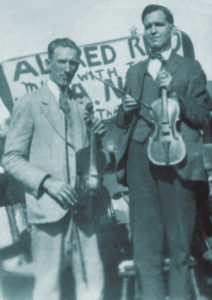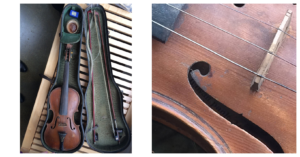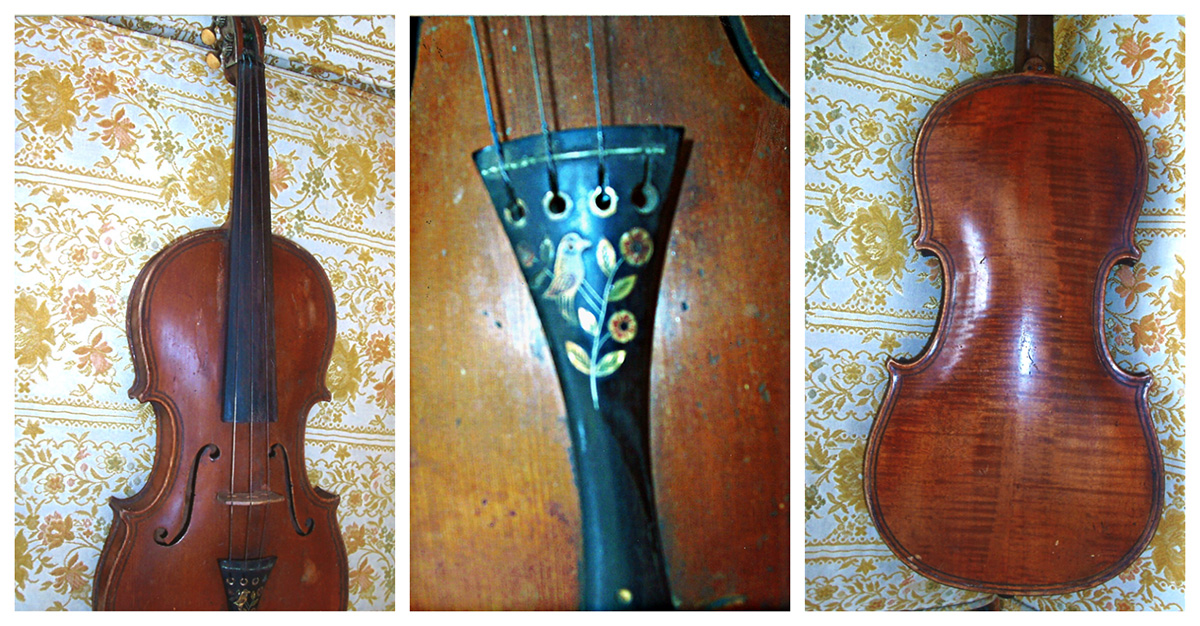“Instrument Interview” posts are a chance to sit down with the instruments of traditional, country, bluegrass, and roots music – from different types of instruments to specific ones related to artists, luthiers, and songwriters – and learn more about them. Several questions are posed, and the instruments answer! Today we talk to Blind Alfred Reed’s fiddle:
First, can you tell us about Blind Alfred Reed?
Sure, I love to talk about him! Blind Alfred Reed was born in Floyd, Virginia, on June 15, 1880, though he spent most of his life in West Virginia, especially around the Princeton area. He was born blind, possibly using a slate and stylus to help him with writing, and he learned how to play the fiddle at a young age.
He was well-known in his area as a talented fiddler and songwriter, and his family remembers him as a multi-instrumentalist who might have also played banjo, guitar, mandolin, and even the organ! Alfred played music anywhere he could – churches, parties, night clubs, political rallies, and dances, and he recorded twice with Victor Talking Machine Company. He gave music lessons and wrote his own compositions, often selling broadsides of his songs.
As with many people during the 1920s and 1930s, Alfred relied on his garden and subsistence farming to help support his family. He also worked as a Methodist lay preacher – he didn’t have his own church, and often preached on street corners instead. Alfred passed away on January 17, 1956.

How did Blind Alfred Reed’s blindness affect his daily life and his musicianship?
Alfred and his sister were both blind from birth, and because they had grown up blind, they had a whole host of different tricks to help them negotiate daily life – from loudly ticking clocks, a wire leading from the house’s door to the outhouse, and memorizing the number of steps it took from different places in the house. Alfred also learned New York Point and American Braille, both tactile reading and writing systems for the blind.
As for music, Alfred’s blindness didn’t hamper his playing and performing. In fact, playing me brought him a lot of pleasure each and every day! He often busked on the streets of Princeton, walking three miles between our home and the city. However, a 1937 statute in the area where he lived banned blind street musicians, and this took away some of our musical money-making opportunities.
Where did Blind Alfred Reed get you?
I have a label inside of me that notes the name Giovanni Maggini and the date 1695, and for a while, Alfred’s family though that I was made by an Italian luthier way back in the past. However, Giovanni Maggini actually died in 1630 so that turned out to not be correct!
A New York violin dealer and restorer took a look at me and determined that I am a commercial instrument, possible advertised and sold through a mail-order company like Sears Roebuck or even from a local music store. Commercial instruments were often made “in the style” of famous instrument makers and so will bear a label inside to reflect that. Alfred owned me by around 1905—1910 so I am probably not much older than that.

Were you part of the 1927 Bristol Sessions?
I certainly was! Ralph Peer personally invited Alfred and me to record at the 1927 Bristol Sessions, and Alfred’s son Arville brought us down from West Virginia to do so. Apparently Ernest “Pop” Stoneman told Mr. Peer about us and the regional popularity of “The Wreck of the Virginian,” a song Alfred wrote about a train wreck that occurred in May 1927. This song was one of the biggest sellers from the 1927 Bristol Sessions.
Besides his train wreck song, Alfred recorded three others at the 1927 Bristol Sessions – “I Mean to Live for Jesus,” “You Must Unload,” and “Walking in the Way with Jesus.” Soon after, he recorded several more songs for Peer and Victor in 1928 and 1929 for a total of 21 sides
In 2016, I traveled to Bristol for the first time since the 1927 Bristol Sessions to celebrate the publication of Blind Alfred Reed: Appalachian Visionary, a book and CD set.

Where else were you played?
As I noted above, a lot of our music-making together was at local events and through street busking. Mr. Peer did invite us – along with Alfred’s son Arville – to record several more songs in 1929 at the official Victor studios up in Camden, New Jersey and New York City. Sadly, after that recording session in December 1929, we didn’t record again, though Alfred kept playing music locally.
Looking back, Alfred probably would’ve been a more popular singer if the Great Depression hadn’t hit – not only did this affect the commercial viability of the music recording industry at this time, but Arville also went off to World War II and so Alfred didn’t really have the opportunity to travel to sing.
However, Alfred has been recognized for his contributions to music since his death. For instance, he was inducted into the West Virginia Music Hall of Fame in 2007.
Did Blind Alfred Reed have a favorite song he played on you?
Alfred didn’t necessarily have a favorite fiddle tune, but he sure loved to play me and he loved writing his own songs. Everything he wrote about was real, based in life’s trials and tribulations, its moments of happiness and sad times. He’s get his ideas from a lot of different sources – through the newspaper stories his wife read to him, by listening to the radio, family and friends telling him the news and local stories, and by reading his Braille Bible.
Alfred has a lot of songs that are recognized as important or particularly interesting songs, and he certainly used music to say something. For instance, his song “How Can a Poor Man Stand Such Times and Live?” outlines the challenges of those living in poverty and thus was especially appropriate to the hard times of the Great Depression. This song was inducted into the Grammy Hall of Fame in 2020. Several of Alfred’s songs were aimed at social ills and other issues he saw as problematic in the 1920s – such as “Money Cravin’ Folks,” “The Prayer of the Drunkard’s Little Girl,” and “Explosion in the Fairmount Mines,” – and because of this socio-political commentary, Alfred is considered one of the early protest singers of the 20th century. However, he also injected some humor into his musical observations – his song “Why Do You Bob Your Hair, Girls?” made a to-do of women’s short hair styles in the 1920s, telling them to ask Jesus for forgiveness!
Despite his recognition as a skilled fiddler and talented songwriter though, Alfred often got his greatest pleasure later in life playing music for his grandkids and hearing them dance around and enjoy his music.
What are you doing now?
Alfred’s family values me and my connection to Alfred and his place in the history of early commercial country music. And so I still live with his grandson, another great musician!
Finally, what’s the difference between a violin and a fiddle?
Oh, this is a good one! The difference between a violin and a fiddle is that one of them has strings and the other one has strangs!
* Dr. Rene Rodgers is the Head Curator of the Museum. Special thanks to Denny Reed and Jane Thompson for their time and stories to help make this “Instrument Interview” possible!


